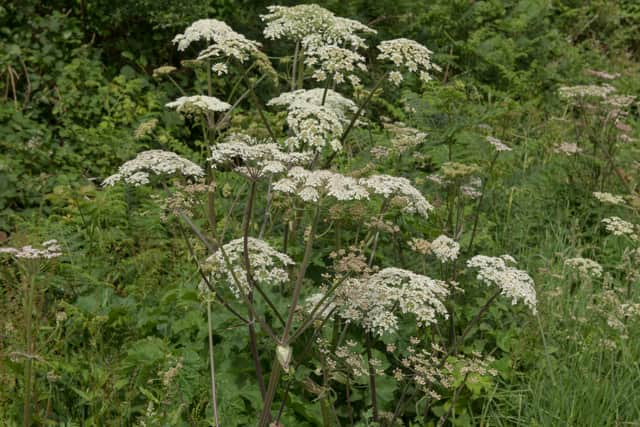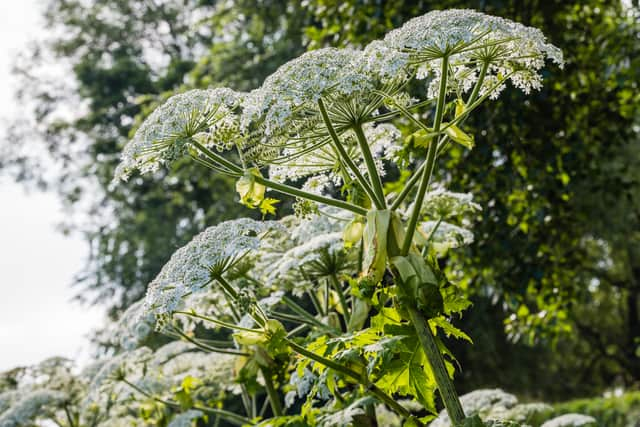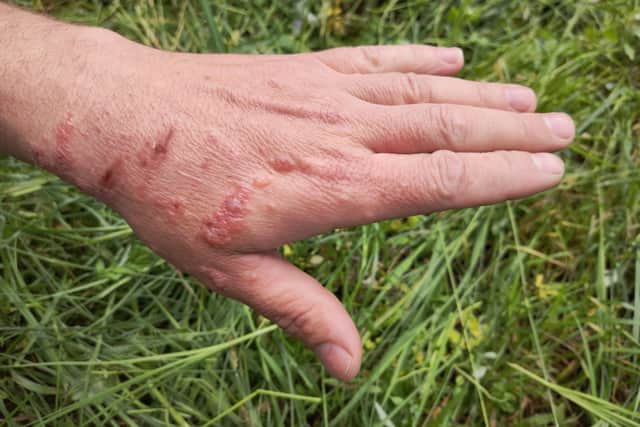Giant hogweed: where poisonous plant is found in UK, how to identify it and how to treat burns
and live on Freeview channel 276
Giant Hogweed is spreading in parts of the UK and can cause serious health problems, including severe burns, painful blisters, and even blindness.
Described as Britain’s ‘most dangerous plant’ the toxic weed can grow up to 20 feet tall and can spread out to cover around two metres of ground.


Advertisement
Hide AdAdvertisement
Hide AdExperts at WhatShed have created a map to track where it is growing, with hotspots including parts of Yorkshire, Birmingham and Manchester.
The plant recently left a 4-year-old child in Bolton with third-degree burns after she touched it while playing in Longsight Park.
It caused her to develop severe blisters that required hospital treatment, prompting the girl’s primary school to issue a warning to parents.
What is giant hogweed?
Giant hogweed, also known by its Latin name Heracleum mantegazzianum, originated in Southern Russia and Georgia, and was first introduced in Britain in the 19th century from the Caucasus Mountains.
Advertisement
Hide AdAdvertisement
Hide AdThe earliest documented reference to the plant has been traced back to the Royal Botanic Gardens Kew Seed List of 1817, where seeds of the plant were listed.
It is part of the Apiaceae family, which includes well-known vegetables and herbs including parsley, carrot, parsnip, coriander and cumin.
The plant has a thick green stem with patches of purple and white hairs on it, and can grow up to 20ft high, while the thick leaves can grow to five feet in width. The flowers usually appear in June and July, and are small and white and appear in clusters on “umbrella-like heads” that face upwards.
It can be easy to confuse giant hogweed with its lookalike cow parsley. You can tell the difference between the two by the height as cow parsely can only grow about three to four feet tall. Cow parsely also has smaller florest and broader leaves which are more rounded compared to the jagged leaves of giant hogweed.


Why is giant hogweed dangerous?
Advertisement
Hide AdAdvertisement
Hide AdThe sap is what makes giant hogweed so dangerous as it contains a chemical called furocoumarin, which makes the skin sensitive to the sun and can cause painful blistering.
In the short-term, touching the plant can result in blisters, rashes and inflamed or irritated skin, but the plant can cause longer lasting effects.
Those worst affected could suffer with potential disfiguration, long-lasting purple blotches and skin irritation that can last for months or even years after coming into contact with the plant.
Giant hogweed can also cause damage to more than just the skin. If the sap gets into your eyes it can cause temporary or permanent damage, and breathing in sap particles can result in respiratory problems.
Advertisement
Hide AdAdvertisement
Hide AdMost people that come into contact with the plant require hospitalisation.
Pet owners are also urged to take care as the plant can cause similar side-effects to dogs.
What should I do if giant hogweed touches my skin?
If you accidentally get giant hogweed sap on your skin, Healthline says that you should wash the area with mild soap and cool water as soon as possible and keep the skin covered when outside to protect it from sunlight.
If a rash or blister begins to form, you should seek medical attention. The treatment required will depend on how severe your reaction is.


Advertisement
Hide AdAdvertisement
Hide AdHealthline states: “Skin irritation that’s caught early might be treated with a steroid cream and nonsteroidal anti-inflammatory drugs, such as ibuprofen, to relieve pain.
“Severe burns could require surgery to graft new skin over the damaged skin.”
Where is Giant Hogweed found?
The plant is found across the UK, but more specifically, it will be growing by river banks where the seeds are transported via the water.
The Royal Horticultural Society (RHS) also says that areas affected by giant hogweed include “gardens and allotments adjacent to infected woodland, healthland or common land”.
Advertisement
Hide AdAdvertisement
Hide AdA map of locations where the plant has been reported can be found on the WhatShed website.
What should I do if I find giant hogweed?
Anyone who comes across giant hogweed should keep their distance to avoid contact with it, as the slightest touch can cause painful burns and blisters.
There is no statutory obligation for landowners to get rid of giant hogweed, but local authorities can help to arrange the disposal of it to remove infestations in public areas.
You can check who your local authority is via the government website.
Comment Guidelines
National World encourages reader discussion on our stories. User feedback, insights and back-and-forth exchanges add a rich layer of context to reporting. Please review our Community Guidelines before commenting.
